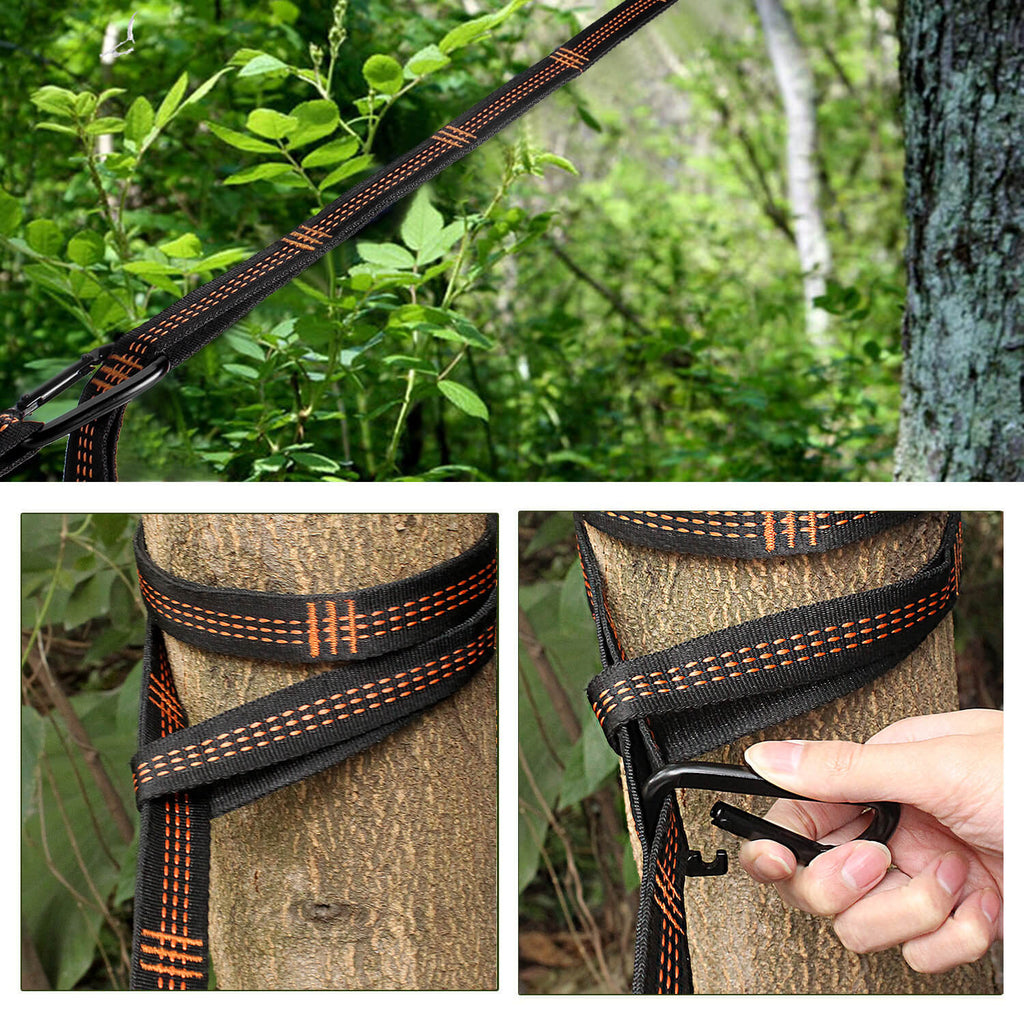You'll heard about hammock which is light and easy-to-carry bedding for camping. But, most of campers who buy hammock for the first time don't know how to use a hammock.Today we’ll show you just what hanging a hammock entails. You’ll learn:
- Why Webbing Is Better Than Rope?
- Where can you set up your hammock?
- How much space do you need to hang a hammock?
- How to adjust your tree straps?
Why Webbing Is Better Than Rope?
When camping, you may see scars on the trunk. These scars probably left by the rope of the hammock. The shape of the rope and the way the rope sticks to the tree may damage the bark. Once the tree outer bark is removed, the inner bark is easily damaged, and the tree's ability to absorb nutrients will also decrease, growth will be negatively affected.Campers felt frustrated when they realized that they were hurting the trees used to support the hammock.
So,how can we hammock camp without destroying trees?
Using webbing type hammock!
The flat straps grip the tree in a way that doesn’t strip the bark,and as easy to use as rope.
Believe that you are a camper who loves nature, the webbing/strap can protect the trees that will be the first choice for setting up your hammock.
Where can you set up your hammock?
Choosing the right location for hanging hammocks is such an important issue in outdoors trip. When considering set up hammocks, a comfortable and safe sleeping environment is essential. Where is a hammock suitable for hanging? At this point, you might immediately think of an idea: hanging on the trees! Probably the most classic way to set up a hammock is between two trees. But that’s not enough to be a proper place. There are a few other factors to consider when hanging a hammock:
- Please make sure that hammocks are allowed in that area. Not all places allow you to hang, tree trunks probably being maintained in some area,you can find out by talking with local land managers.
- When you find a pair of potential hammock trees, check them carefully. Check whether there are sensitive plants and wildlife habitats around, as well as hazards such as insect nests and poisonous plants.
- Please do not hang the hammock on the route where people or animals may pass, not safe for both.Even you can’t see a dilapidated road, check the surrounding terrain to see if this is a route to a creek or lake.
- You probably think it is cool to set up a hammock on the lake or beside the river. Strictly speaking, that’s not safe. Imagine you get the wrong direction to get off the hammock when you’re not awake.
- Make sure the trees you're using for your hammock can support your weight. You don't want to choose two thin young trees to hang, so keep an eye out for healthy, sturdy, strong tree.
-How much space do you need to hang a hammock?
When hammock, you need to consider some factors related to weight and strength. Suppose you want to camp and want to hang a hammock between two trees. First of all, you need to consider "Hammock Ridge Length", which is a fancy term that we use in the hammock community to define the length of your hammock. You will obviously want the distance between the trees to be longer than your Hammock Ridgeline Length, and you will need to factor in the height and length of your hanging tools as well.
- Distance between trees
Measure the distance between your two desired trees. Now ensure the hammocks total length is at least 1m less than the total distance between the trees to give enough distance for your hanging tree packs, probably you will need 10 to 15 feet of distance between trees, depending on the length and style of your hammock. No two trees are exactly the same and we don't have any trouble finding a way to hang our hammocks thanks to how adjustable tree straps are!
-Height on trees
The ideal sitting height between the ground and the hammock is an average chair height of 18 feet, allowing you to easily sit on the hammock and feel comfortable.
When hanging hammocks between trees, aim to have the hammock’s suspension (rope, strap, cord, chain, etc.) hang at a 30-degree angle which will provide the right amount of force.
-How to adjust your tree straps?
Try to choose tree straps with adjustable loops, which will make it easier for you to hang your hammock according to the distance between the trees.
Tree strap securely around the two tree trunks. Then use a knot, a carabiner, or other hardware to attach the suspension to the eye (end-loops) of the hammock.
- Wrap hommock straps around sturdy objects.
- Please strap end throught loop
- Pull straps end tight prior to hanging hammock
- Attach hammock carbabiners to the loops on the straps
Final tips and tricks
Environment and circumstance always dictate your needs, so if you sleep outdoors in a hammock, the choice is obvious: you can either camp in a hammock made of nylon or parachute silk, or use a traditional (classic) waterproof one. Camp hammocks are the most common choice because they are lightweight, easy to transport, easy to install, and most are quick to dry.
Choose the right location for your hammock: Consider the no-trace principle, such as hammocks away from water, and hammocks in fixed locations where there is no vegetation to destroy. Also check under and around the hammock for anything that could hurt you if you fall.
Remember to take down your hammock when you leave for the day, avoiding stuck the kids or animals as well as protect your hammock.
Finally,In summer,don’t forgot bring hammock Bug Net !













Dejar un comentario